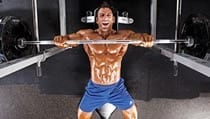If you want to get your bench numbers up, it is all about technique and strengthening your chest, shoulders, and back. Make sure you set up with lots of tension on the bench by driving your feet down into the ground and your upper traps into the bench. Pull your shoulders back and keep your chest up to finish the intitial setup.
Instead of lowering the weight, think about “rowing” the weight down to keep tension on your lats and maintain a good foundation. Also, make sure that your elbows track at about 45 degree out from your sides, and not flared out in line with the top of your shoulders. When the bar touches your chest, drive your feet down into the ground and jam it back upward in a straight line.
Compound Moves
To drive up your numbers, you should also incorporate compound exercises into your program to build the muscles that build a big bench, i.e., the shoulders, triceps, and chest.
I love heavy dumbbell military presses and shrugs to build the shoulders and traps. We typically stick in the 3-4 sets of 8-12 rep range. To develop a massive back, you can’t go wrong with heavy t-bar rows, bent over barbell rows, and chin-ups. These 3 exercises should form the cornerstone of your back training. In addition to bench pressing with a barbell, you should be hitting a ton of push-ups and dumbbell bench press variations. Crush them for high reps and even push into the 20, 30, 50 rep range.
Finally, as with any specific lift, to get better at it, you need to regularly incorporate it into your workouts.
To hit a full squat, you need both good mobility and good stability. Mobility means you can move through the squat pattern unrestricted, and stability means you can control your body and contract the right muscles through the entire range of motion.
Good mobility at the ankles, hips and upper back is critical to allowing you to hit a better squat through a greater range of motion. Our bodies are typically restricted at these joint segments so you have to constantly work on opening these restrictions. Hip flexor stretches, ankle mobilization drills against the cage, and thoracic extension on the foam roller are all great drills.
To gain greater stability, you can hit Anderson squats at various heights. Anderson squats – named after the famous Paul Anderson one of the greatest strongmen ever and famous for regularly squat train wheels – are done where you setup a barbell on the cage pins at different heights and squat the weight from a dead stop off of these pins. This will allow you to not only work on your body position at these different heights, but also create stability at those specific joint angles. Three common cage pin height positions would be at a quarter squat, a parallel squat, and slightly below parallel.
Also two final things to consider are the bar position and using weightlifting shoes. A higher bar position will allow you to stay more upright throughout the lift. While a lower bar position, typically reserved for box squats or powerlifting squats, will throw your torso more forward as you squat down. Also, weightlifting shoes that have a firm sole and raised heel, can also put you in a more upright position and compensate for lack of mobility in your ankles.








